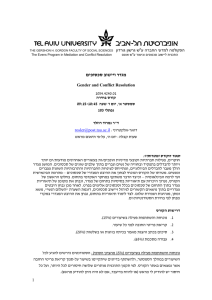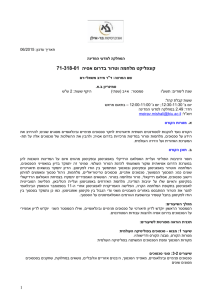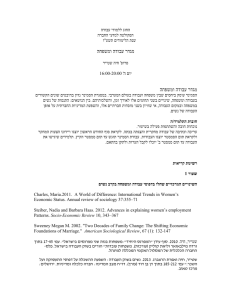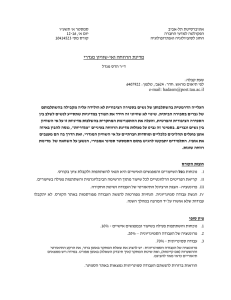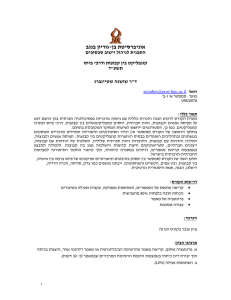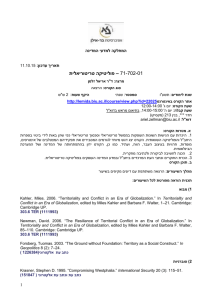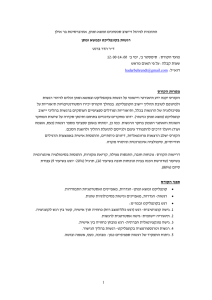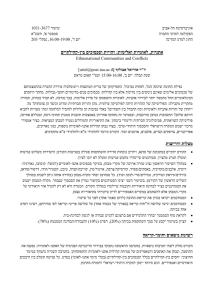27-764 מגדר ויישוב סכסוכים
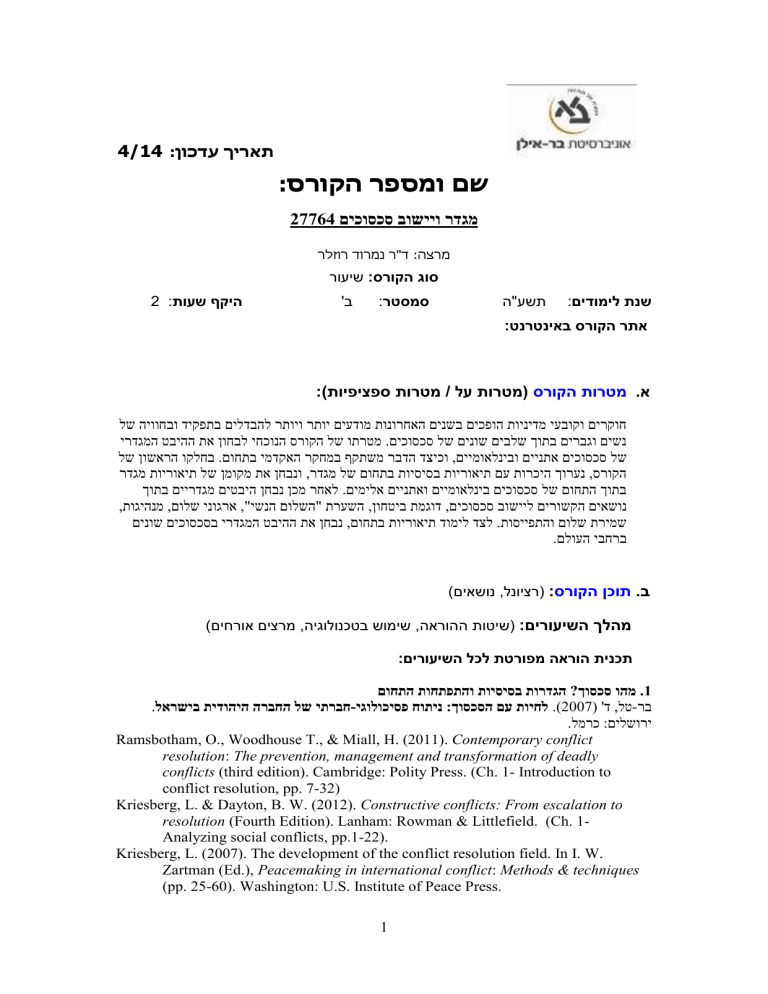
4/14 :ןוכדע ךיראת
: סרוקה רפסמו םש
27764 םיכוסכס בושייו רדגמ
רלזור דורמנ ר"ד :הצרמ
רועיש :סרוקה גוס
2 : תועש ףקיה 'ב : רטסמס ה"עשת : םידומיל תנש
: טנרטניאב סרוקה רתא
: )תויפיצפס תורטמ / לע תורטמ( סרוקה תורטמ
לש היווחבו דיקפתב םילדבהל רתויו רתוי םיעדומ תונורחאה םינשב םיכפוה תוינידמ יעבוקו םירקוח
ירדגמה טביהה תא ןוחבל יחכונה סרוקה לש ותרטמ .םיכוסכס לש םינוש םיבלש ךותב םירבגו םישנ
לש ןושארה וקלחב .םוחתב ימדקאה רקחמב ףקתשמ רבדה דציכו ,םיי מואלניבו םיינתא םיכוסכס לש
רדגמ תוירואית לש ןמוקמ תא ןחבנו ,רדגמ לש םוחתב תויסיסב תוירואית םע תורכיה ךורענ ,סרוקה
ךותב םיירדגמ םיטביה ןחבנ ןכמ רחאל .םימילא םיינתאו םיימואלניב םיכוסכס לש םוחתה ךותב
,תוגיהנמ ,םולש ינוגרא ,"ישנה םולשה" תרעשה ,ןוחטיב תמגוד ,ם יכוסכס בושייל םירושקה םיאשונ
םינוש םיכוסכסב ירדגמה טביהה תא ןחבנ ,םוחתב תוירואית דומיל דצל .תוסייפתהו םולש תרימש
.םלועה יבחרב
.
א
)םיאשונ ,לנויצר (
: סרוקה ןכות .ב
) םיחרוא םיצרמ ,היגולונכטב שומיש ,הארוהה ת ו טיש(
:םירועישה ךלהמ
:םירועישה לכל תטרופמ הארוה תינכת
.
לארשיב תידוהיה הרבחה לש יתרבח -
םוחתה תוחתפתהו תויסיסב תורדגה ?ךוסכס והמ .
1
יגולוכיספ חותינ :ךוסכסה םע תויחל .) 2007 ( 'ד ,לט רב
.למרכ :םילשורי
Ramsbotham, O., Woodhouse T., & Miall, H. (2011). Contemporary conflict resolution : The prevention, management and transformation of deadly conflicts (third edition). Cambridge: Polity Press. (Ch. 1- Introduction to conflict resolution, pp. 7-32)
Kriesberg, L. & Dayton, B. W. (2012). Constructive conflicts: From escalation to resolution (Fourth Edition). Lanham: Rowman & Littlefield. (Ch. 1-
Analyzing social conflicts, pp.1-22).
Kriesberg, L. (2007). The development of the conflict resolution field. In I. W.
Zartman (Ed.), Peacemaking in international conflict : Methods & techniques
(pp. 25-60). Washington: U.S. Institute of Peace Press.
1
Mitchell, C. R. (1981). The structure of international conflict . New-York: St. Martin’s
Press.
תיטסינימפ הבישחל םי כרד ,)תוכרוע( ימת רזואה -
.
2008
תושיגו תורדגה ?רדגמ והמ .
2
ליאמע ,הנח הונ ,ילרוא ןיבול ,רמת רואלא ,הצינ יאני
,ביבא לת ,החותפה הטיסרבינואה ,
.םילעופה תירפס .
הארקמ :רדגמ ידומילל אובמ
הנוש לוקב .) 1995
–
( לורק ,ןגיליג
Blanchard, Eric M., 2003. ‘Gender, international relations, and the evelopment of feminist security theory’.
Signs 28(4): 1289 - 1312.
Saprio, Virginia (2003) “Theorizing Gender in Political Psychology Research”. In
Sears, David O; Leonie Huddy & Robert Jervis, Eds., Oxford Handbook of Political
Psychology, Oxford: Oxford University Press, pp. 601 – 634
Mackenzie, Catriona and Natalie Stoljar, Eds. (2000). Relational Autonomy: Feminist
Perspectives on Autonomy, Agency and the Social Self . Oxford, Oxford University
Press.
Boulding, E. (1976). The underside of history: A view of women through time .
Boulder, CO: Westview Press.
לגופ היבליס ,הונ הנח ,ןסח ראנמ ,גוצרה הנח ,בלכ
.
1999
-
ל"ניבו םיינתא םיכוסכסב דמימכ רדגמ .
3
ןאהד טיירנה ,ןמדירפ הלאירא ,הנפד ,ילאערזי
,םודא וק תרדס ,דחואמה ץוביקה .הקיטילופ רדגימ ןימ . ,)תוכרוע( יוא'זיב
.
תודדומתהו חוכ יסחי ,תוהז :לארשיב תויניטסלפ םישנ .)תוכרוע( ימענ יול רניוו רדיווק העיבר ובא
.
2010 ,םילשורי ,ריל ןו ןוכמ תאצוה
Jenkins, T., & Reardon, B. A. (2007). Towards a gender-inclusive, holistic perspective. In C. Webel, & J. Galtung (Eds.), Handbook of peace and conflict studies . Routledge.
Boulding, E. (2000). Cultures of peace: The hidden side of history . Syracuse, NY:
Syracuse University Press.
Conover, P. J., & Sapiro, V. (1993). Gender, feminist consciousness, and war.
American Journal of Political Science, 37 (4), 1079-1099.
Ramsbotham, O., Woodhouse T., & Miall, H. (2011). Contemporary conflict resolution : The prevention, management and transformation of deadly conflicts (third edition). Cambridge: Polity Press. (Ch. 11 – Gender and conflict resolution, pp. 305-316)
J. Ann Tickner, Gender in World Politics , New York: Columbia University Press,
2005.
Inger Skjelsbæk,
Gendered Battlefields: A Gender Analysis of Peace and Conflict .
PRIO Report 6/97
לת ,ד חואמה ץוביקהו סנגאמ תאצוה ,
ךוסכסב תומילאו רדגמ .
ילארשיה אבצב תוישנו תוירבג :םידמב תויוהז ,הנרוא יול
4
ןושש
.
2006
Caprioli, M. and M. Boyer (2001). “Gender, violence, and international crisis.”
Journal of Conflict Resolution, 40(4), 503–518.
,ביבא
Salla, M. (2001). Women and war, men and pacifism. In I. Skjelsboek & D. Smith
(Eds.). Gender, peace and conflict (pp. 68-79). London: Sage.
Alison, M. H. (2009). Women and political violence: Female combatants in ethnonational conflict . London: Routledge.
Skjelsbæk, Inger (2001) “Sexual Violence and War: Mapping Out a Complex
2
Relationship”.
European Journal of International Relations 7(2): 211 – 237.
I. Breines, R.W. Connell and I. Eide (eds.) (2000). Male roles, masculinities and violence: A culture of peace perspective . Paris: UNESCO Publishing
McEvoy, S. (2009). Loyalist women paramilitaries in Northern Ireland: Beginning a feminist conversation about conflict resolution. Security Studies, 18 (2), 262-
286.
Mazurana, D. (2005). Gender and the causes and consequences of armed conflict. In
D. Mazurana, A. Raven-Roberts, & J. Parpart (Eds.). Gender, conflict, and peacekeeping (pp. 27-54). Lanham: Rowman & Littlefield.
Campanaro, J. (2000). Women, war, and international law: The historical treatment of gender-based war crimes. Geo. LJ , 89 , 2557.
Bérubé, A. (2010).
Coming Out Under Fire: The History of Gay Men and Women in
World War II: The History of Gay Men and Women in World War II . University of
North Carolina Press.
םיטביה : 1325 ןוחטיבה תצעומ תטלחה ?ןלוכ םישנה הפיא .)
םיכוסכס בושייו ןוחטיב ,רדגמ .
2004
5
( )תוכרוע( .ר ,בידו .ש ,ינורהא
.סדרפ :הפיח .
י ניטסלפ ילארשיה ךוסכסה לש םיירדגמ
United Nations (2002). Women, peace and security : Study submitted by the Secretary-
General pursuant to Security Council resolution 1325 (2000) . United Nations
Publication.
United Nations Security Council (2000). United Nations Security Council Resolution
1325: http://www.peacewomen.org/un/sc/res1325.pdf.
Cohn, C., Kinsella, H., & Gibbings, S. (2004). Women, Peace and Security
Resolution 1325. International Feminist Journal of Politics , 6 (1), 130-140.
Special issue of Security Dialogue, ‘Gender and Security,’ Prio, 2004, 12, 1.
"ישנה םולשה" תרעשה .
Eichenberg, R. C. (2003). Gender differences in public attitudes toward the use of
6 force by the United States, 1990–2003. International Security, 28 (1), 110-141.
Fite, D., M. Genest and C. Wilcox (1990). Gender di ff erence in foreign policy attitudes. American Political Quarterly, 18, 492–513.
Tessler, M., & Warriner, I. (1997). Gender, feminism, and attitudes toward international conflict: Exploring relationships with survey data from the Middle
East. World Politics, 49 (2), 250-281.
Tessler, M., J. Nachtway and A. Grant (1999). “Further tests of the women and peace hypothesis: Evidence from cross-national survey research in the Middle East.”
International Studies Quarterly, 43, 519–531.
Togeby, L. (1994). The gender gap in foreign policy attitudes. Journal of Peace
Research, 31 (4), 375-392.
Wilcox, C., Hewitt, L., & Allsop, D. (1996). The gender gap in attitudes toward the
Gulf War: A cross-national perspective. Journal of Peace Research, 33 (1), 67-82.
Bendyna, M. E., Finucane, T., Kirby, L., O'Donnell, J. P., & Wilcox, C. (1996).
Gender differences in public attitudes toward the Gulf War: A test of competing hypotheses. The Social Science Journal, 33 (1), 1-22.
םולש ינוגראו םישנ .
El-Bushra, J. (2007). Feminism, Gender, and women's peace activism. Development
7 and Change, 38 (1), 131-147.
3
Blumen, O., & Halevi, S. (2009). Staging peace through a gendered demonstration:
Women in Black in Haifa, Israel. Annals of the Association of American
Geographers, 99 (5), 977-985.
Samuel, K. (2001). Gender difference in conflict resolution: The case of Sri Lanka. In
Gender, Peace and Conflict .
Clemens, E. (1993). Organizational repertoires and institutional change: Women's groups and the transformation of US politics, 1890-1920. The American
Journal of Sociology, 98 (4), 755-798.
Gordon, L. (1990). The peaceful sex? On feminism and the Peace Movement. NWSA
Journal, 2 (4), 624-634.
םיכוסכס בושייב תוגיהנמו רדגמ
Gormley-Heenan, C. (2007). Political leadership and the Northern Ireland peace
.
8 process: Role, capacity and effect . Hampshire: Palgrave Macmillan.
Haslam, S. A., Reicher, S., & Platow, M. (2011). The new psychology of leadership:
Identity, influence and power . New York: Psychology Press.
Fine, M. G. (2009). Women leaders' discursive constructions of leadership.
Women's
Studies in Communication, 32 (2), 180-202.
Dahlerup, D. (2001). Women in Political Decisionmaking. In Gender, peace and conflict ,
Mowlam, Mo. (2002), Momentum: The Struggle for Peace, Politics, and the People .
London: Hodder and Stoughton.
מ"ומ יכילהתו רדגמ .
9
Pruitt, D. G. (2011). Negotiation and mediation in intergroup conflict. In D. Bar-Tal
(Ed.) Intergroup conflicts and their resolution: Social psychological perspective. New-York: Psychology Press.
Stamato, L. (1992). Voice, place, and process: Research on gender, negotiation, and conflict resolution. Mediation Quarterly , 9 (4), 375-386.
Byrne, S. (2013). Troubled engagement in ethnicized conflict: Negotiating difference among feminist activists in Israel and Northern Ireland. International Feminist
Journal of Politics , 1-21.
Maoz, I. (2009). The Women and Peace Hypothesis? The Effect of Opponent
Negotiators' Gender on the Evaluation of Compromise Solutions in the Israeli-
Palestinian Conflict. International Negotiation , 14 (3), 519-536.
Track II
ו רדגמ .
10
Fisher, R. J. (2007). Interactive conflict resolution. In Peacemaking in international conflicts (pp. 227-272). d'Estree, T. P. , & Babbitt, E. F. (1998). Women and the art of peacemaking: Data from Israeli-Palestinian interactive problem-solving workshops. Political
Psychology, 19 (1), 185–209.
Tuft, E. I. (2001). Integrating a Gender Perspective in Conflict Resolution: The
Colombian Case. In Gender, Peace and Conflict .
Ashe, F. (2009). From paramilitaries to peacemakers: The gender dynamics of community-based restorative justice in Northern Ireland. The British Journal of
Politics & International Relations, 11 (2), 298-314.
4
םולש תרימשו רדגמ .
11
Mazurana, D., & Raven-Roberts, A. Jane Parpart with Sue Lautze (2005).
Introduction: Gender, Conflict, and Peacekeeping. In D. Mazurana, A. Raven-
Roberts, & J. Parpart (Eds.). Gender, conflict, and peacekeeping (pp. 1-26). Lanham:
Rowman & Littlefield.
Special issue on ‘Women and International Peacekeeping, editors Torunn Tryggestad and
Louise Olsson. International Peacekeeping , vol .8 , summer 2001, nr.2.
Raven-Roberts, Angela (2005), ‘Gender Mainstreaming in United Nations
Peacekeeping Operations: Talking the Talk, Tripping over the Walk’, in Dyan
Mazurana (et al) Gender, Conflict and Peacekeeping, Rowman and Littlefield
Publishers
Hudson, H. (2005). Peacekeeping Trends and Their Gender Implications for Regional
Peacekeeping Forces in Africa: Progress and Challenges. Gender, Conflict, and
Peacekeeping , 111-133.
Vandenberg, M. (2005). Peacekeeping, alphabet soup, and violence against women in the Balkans. Gender, Conflict, and Peacekeeping, Rowman & Littlefield: Oxford &
Boulder .
.
35-58 , 9 ,הקיטילופ
תוסייפתה יכילהתו רדגמ .
,תימואלניבה הריזבו תימינפה הריזב תוסייפתה תולועפ .)
12
2002 ( 'ל ,גרבסירק
.
59-75 , 9 ,
.
9-34
הקיטילופ
, 9 , הקיטילופ , תוסייפתהה תוהמ .) 2002 ( 'ג
.תוסייפתהל ביצי םולש ןיב הקיטקלאיד .) 2002
, קנינבו
( 'י ,בוט
'ד ,לט -
ןמיס -
רב
רב
Helms, E. (2003). Women as agents of ethnic reconciliation? Women's NGOs and international intervention in postwar Bosnia-Herzegovina. Women's Studies
International Forum, 26 (1), 15-33.
Meintjes, Sheila, Anu Pillay & Meredeth Turshen (2001), eds, The Aftermath. Women in Post-Conflict Transformation , Zed Books: London & New York.
Wilson, J. Z. (2005). State making, peacemaking, and the inscription of gendered politics into peace: Lessons from Angola. Gender, Complex Emergencies, and
Peacekeeping: National and International Feminist Perspectives .
Baines, E. K. (2005). Les femmes aux mille bras: building peace in Rwanda.
Gender,
Conflict, and Peacekeeping , 220-241
: סרוקה תובוח .ג
ןיא :םדק תושירד
:תולטמ / תושירד / תובוח
הדובע 80%
תופתתשה 20%
ירפסמ : )רבוע ןויצ / ירפסמ ןויצ( יפוסה ןויצה יביכרמ
5
